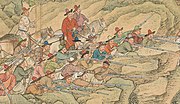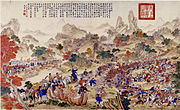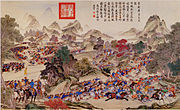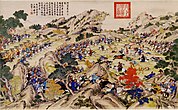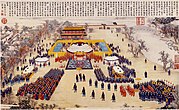Revolt of the Altishahr Khojas
You can help expand this article with text translated from the corresponding article in Chinese. (October 2015) Click [show] for important translation instructions.
|
| Revolt of the Altishahr Khojas | |||||||
|---|---|---|---|---|---|---|---|
 Khoja rebels and Qing soldiers fighting at the Battle of Yesil-kol-nor near Yashilkul Lake, 1759. Painted by Jean-Damascène Sallusti in 1764. | |||||||
| |||||||
| Belligerents | |||||||
| Altishahr Khojas |
Qing dynasty Badakhshan | ||||||
| Commanders and leaders | |||||||
|
Khwāja Jihān[1] Burhān ud-Dīn[1] Abdul Karim ʿAbd ul-Khāliq 哈三愛的爾 鄂斯滿 沙喇斯 瑪呼斯 | (Manchu) | ||||||
| Strength | |||||||
|
Hojijan >10,000 Buranidun >5,000[2] |
c. 200,000 in the later stages (Khalkha Mongols, Dzungars, Eight Banners, Green Standard Army, Mongolian Eight Banners, Hui Battalion (回營; Uygurs), Chahar Banner, Solons, Kyrgyzs) | ||||||
| Casualties and losses | |||||||
| Unknown | Unknown | ||||||
The Revolt of the Altishahr Khojas (
After the Qing conquest of Dzungaria at the end of the
In 1757, Hojijan killed the Qing
With the revolt pacified, the Qing completed the reintegration of their territory in one of Qianlong's Ten Great Campaigns. The end of the conflict saw the restoration of the territory south of the Tian Shan to Qing control meaning that the Qing now controlled the whole of Xinjiang.
After the appointment of an Altishahr Grand Ministerial Attache the Xinjiang area remained peaceful for the next 60 years.
Background
The White Mountain Khoja and the Zhuo Clan
The ancestor of the Khoja brothers was
In the middle of the

In 1680, during the reign of the
The riots of around 1682[7] led to the overthrow of Muhammad Amin Khan by the followers of Afaq Khoja, whose son Yahya Khoja became the ruler of Yarkand and Kashgar.[6]
Two years later, Afaq Khoja died and the Kashgar region sank into a civil war involving the Yarkand Khanate, White Mountain Khoja,
After Tsewang Rabtan succeeded to the leadership of the Dzungar Khanate in 1697 he imprisoned the descendants of the Altishahr Khojas in what is now known as Ili Kazakh Autonomous Prefecture. When Galdan Tseren came to power in 1727, he gave Black Mountain Khoja, Daniyal (Persian: خواجہ دانیال; simplified Chinese: 达涅尔; traditional Chinese: 達涅爾; pinyin: Dániè'ěr) responsibility for the political and economic affairs of Yarkand and Kashgar. At the same time, Afaq Khoja's grandson Mahmud (玛罕木特) died in captivity. Afaq's second grandson Buranidun, the "Elder Khoja", was imprisoned east of Yili at Elinhabi'erga (額林哈畢爾噶) (now Yilianhabi'ergaishan 依连哈比尔尕山) in the custody of the local Dzungar Tribal Administrator or Zaisang (宰桑), Abagasi (阿巴噶斯) and his brother Hadan (哈丹).
Dawachi and Amursana split
After Galdan Tseren died in 1745, the Dzungar Khanate fell into internecine warfare. In the end,
However, in 1754, Dawachi and Amursana quarreled and the latter defected to the Qing, taking with him 5,000 soldiers and 20,000 women and children.[8] He then demanded permission to travel to Beijing and seek the emperor's assistance in defeating Dawachi and retaking Ili and neighbouring Kashgar. Amursana's persuasive manner and Qianlongs's ambition and love for military renown meant that in the end he agreed,[9] throwing in a princedom of the first degree (雙親王; 双亲王), which entitled Amursana to double stipends and privileges, as a bonus.[8]
Surrender of the Dzungars
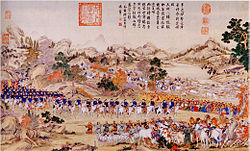

In the first lunar month of 1755, two units of the Qing army, each consisting of 25,000 men carrying two months' of rations per man,[10] entered Dzungaria from two different directions to destroy Dawachi's army and retake the territory. The Northern Route Army under commander Ban Di comprised Border Pacifying Vice-general of the Left Wing Amursana, Amban Sebutangbalezhu'er and Mukden Commander Alantai while Border Pacifying Vice-general of the Right Wing Salar 薩喇勒 and Minister of the Interior (內大臣) Erong'an (鄂容安) formed the Western Route Army with the West Pacifying General (定西將軍; Dìngxī jiāngjūn) Yong Chang in command. The two armies linked up at Boluotala (博羅塔拉; now the Bortala Mongol Autonomous Prefecture). During the subsequent march, Abagasi and Hadan among others surrendered to the Qing forces.
On 8 April 1755, Buranidun surrendered to Salar's Western Route Army saying "At the time of Galdan Tseren, my father was imprisoned and thus far I have not been released. I will bring perhaps 30 of my households to surrender to the emperor and become his servants"[A][11] Not long afterwards, the Younger Khoja, Hojijan, surrendered to Ban Di with Hadan.[12]
In May, Qing forces entered Huocheng County in Ili. Ban Di planned to send Buranidun to Beijing for presentation to the emperor while Hojijan would be kept in Ili in the care of the nomadic Muslim Taranchi.
The
At the same time,
Amursana's Revolt
With Dawachi on his way to Beijing as a captive, Amursana now saw an opportunity to establish himself as the new Dzungar Khan with control of the four Oirat tribes of Dzungaria. Qianlong had other ideas. The emperor knew that Amursana had long had his sights set on Dzungaria but "had not dared to do anything rash."
In March 1756, West Pacifying General Celeng Celeng arrived with the Western Route Army to recapture Ili. Amursana fled into the Kazakh Khanate as the tables were once again turned on him. Hojijan and Buranidun united the local population in May, then the Younger Khoja killed Amursana's envoy. Tuoluntai defected to the rebel side and was sent to ascertain the strength of the Qing Garrison in Ili.[19]
Course of events
Hojijan's move against the Qing

Hojijan sought independence from the Qing regime and told the local clan leaders: "I have just escaped from the slavery of the Dzungars; now it seems I must surrender to the Qing and pay tribute. Although inferior to ruling the region, working the land and defending the cities is sufficient resistance."[D] Buranidun was unwilling to take on the Qing Army: "We were once Humiliated by Dzungaria; Without the aid of the Qing military, how could we have returned to our homeland? We must not turn our backs on kindness and fight with Qing."[E][20]
An envoy sent by Hoijijan then killed
-
Khojas troops at the Battle of Yesil-kol-nor (1759). By Jean-Damascène Sallusti
-
The surrender of the leader Khojis of Wushi (乌什, Us-Turfan in Uyghur) in 1758. By Jean-Damascène Sallusti
-
Zhao Hui was unable to takeYarkand, moved east but was forced to retreat by the rebels, who lay siege to him at the Black River. In 1759, Zhao Hui learnt of the imminent arrival of relief troops, and so stormed the rebel town and brought the rebellion to an end. Painting by Giuseppe Castiglione
-
Battle of Qurman, 1759. General Fu De, on his way to relieve the siege of Khorgos, was suddenly attacked by an enemy force of 5,000 Muslim cavalry and with less than 600 men Fu De defeated the Muslims. By Jean-Damascène Sallusti
-
Battle of Tonguzluq, 1758. General Zhao Hui tries to take Yarkand but is defeated. Painting by Giuseppe Castiglione
-
Battle of Qos-Qulaq, 1759. Chinese General Ming Rui defeats the Khoja army in Qos-Qulaq (north of Kara-Kul, Tajikistan). Painting by Giuseppe Castiglione
-
Qing defeat the Khoja at Arcul, after they had retreated following the battle of Qos-Qulaq, 1759. Painting by Jean Denis Attiret.
-
The Chinese army defeats the Khoja brothers (Burhān al-Dīn and Khwāja-i Jahān) in Yesil-Kol-Nor (present-day Yashil Kul, Tajikistan), 1759. By Jean-Damascène Sallusti
-
The Khan of Badakhsan asks to surrender, 1759. Painting y Jean-Damascène Sallusti
-
The prisoners are presented at the palace gate of Wumen. The emperor is also offered the head of the Khoja Huo Jizhan. Painting byJean-Denis Attiret
-
The emperor in the suburbs personally receives news of the officers and soldiers who distinguished themselves in the campaign against the Muslim tribes. By Jean-Damascène Sallusti
-
A victory banquet given by the emperor to the distinguished officers and soldiers of the Huibu Rebellion (1758-1759). Painting by Giuseppe Castiglione
Notes
- ^ Original Chinese: "我父縛來為質,至今並不將我等放回。我等情願帶領屬下三十餘戶投降大皇帝為臣僕"
- ^ During Qing dynasty, the government appointed a beg as the effective ruler of each town in the Muslim areas (Huibu; 回部) of Xinjiang.
- ^ Original Chinese: "料伊亦不敢遽爾妄行"
- ^ Original Chinese: "甫免為厄魯特(準噶爾)役使,今若投誠,又當納貢。不若自長一方,種地守城,足為捍禦。"
- ^ Original Chinese: "從前受辱於厄魯特,非大國(清)兵力,安能復歸故土?恩不可負,即兵力亦斷不能抗。"
- ^ Original Chinese: "我兄弟自祖父三世,俱被準噶爾囚禁。荷蒙天恩釋放,仍為回部頭目,受恩深重。若爾有負天朝,任爾自為,我必不能聽從"
References
- ^ a b 佐口 透. "カシュガル=ホージャ家の後裔" (in Japanese).
- ^ 《18-19世紀新疆社會史研究》,76頁 (18th-19th Century Xinjiang Social Research, Page 76) (in Chinese)
- ISBN 978-0-230-10787-8.
- ISBN 978-1-134-35305-7.
- ISBN 978-0-8122-0531-2.
- ^ ISBN 978-92-3-103876-1.
- ^ Liu & Wei 1998, p. 215.
- ^ a b c d Hummel 1943, p. 10.
- ^ Alikuzai 2013, p. 302.
- ^ Perdue 2009, p. 272.
- ^ "正編卷十 (Compilation Scroll 10)". 《平定準噶爾方略》 [The Dzungaria Strategy]. 1772.
- ^ Liu & Wei 1998, p. 242.
- ^ Dani & Masson 2003, p. 201.
- ^ 《和卓傳》 漢文節譯本 [Khoja Annals - Chinese Translation]. p. 113.
- ^ 《和卓傳》 漢文節譯本 [Khoja Annals - Chinese Translation]. p. 121.
- ^ 《高宗實錄》 [Gaozong (Qianlong) True Record] (in Chinese). Vol. 卷四百八十九 (Scroll 489).
- ^ "額色尹傳 (Eseyin Biography)". 《外藩蒙古回部王公表傳》 [Biographies of the Muslim Nobility Beyond Mongolia] (in Chinese). Vol. 卷一百一十七 (Scroll 117).
- ^ Zhun'ge'er Qi (1772). "正編卷二十九,乾隆二十一年六月己酉引宰桑固英哈什哈語 (Compilation Scroll 29; Qianlong 21st Year, Sixth Month)". 《平定準噶爾方略》 [The Dzungaria Pacification Plan] (in Chinese).
- ^ Zhun'ge'er Qi (1772). "正編卷三十二,乾隆二十一年閏九月丙午 (Compilation Scroll 29; Qianlong 21st Year, Ninth Month)". 《平定準噶爾方略》 [The Dzungaria Pacification Plan] (in Chinese).
- ^ Zhun'ge'er Qi (1772). "正編卷五十八 (Compilation Scroll 58)". 《平定準噶爾方略》 [The Dzungaria Pacification Plan] (in Chinese).
- ^ Zhun'ge'er Qi (1772). "正編卷三十三 (Compilation Scroll 33)". 《平定準噶爾方略》 [The Dzungaria Pacification Plan] (in Chinese).
- ^ 《18-19世紀新疆社會史研究》 [Research into the Social History of Xinjiang in the 18-19th Century] (in Chinese). pp. 40, 43.
- Bibliography
- Alikuzai, Hamid Wahed (2013). A Concise History of Afghanistan in 25 Volumes. Vol. 14. Trafford Publishing. ISBN 978-1-4907-1441-7.
- Dani, Ahmad Hasan; Masson, Vadim Mikhaĭlovich (2003). History of Civilizations of Central Asia: Development in contrast : from the sixteenth to the mid-nineteenth century. UNESCO. ISBN 978-92-3-103876-1.
- Hummel, Arthur W. Sr., ed. (1943). . Eminent Chinese of the Ch'ing Period. United States Government Printing Office.
- Perdue, Peter C (2009). China Marches West: The Qing Conquest of Central Eurasia. Harvard University Press. ISBN 978-0-674-04202-5.
- Liu, Zhengyin; Wei, Liangtao (1998). 《西域和卓家族研究》 [Research Paper on the Khoja Clan of the Western Regions] (in Chinese). 中国社会科学出版社 (China Social Sciences Publishing). ISBN 978-7500423782.

